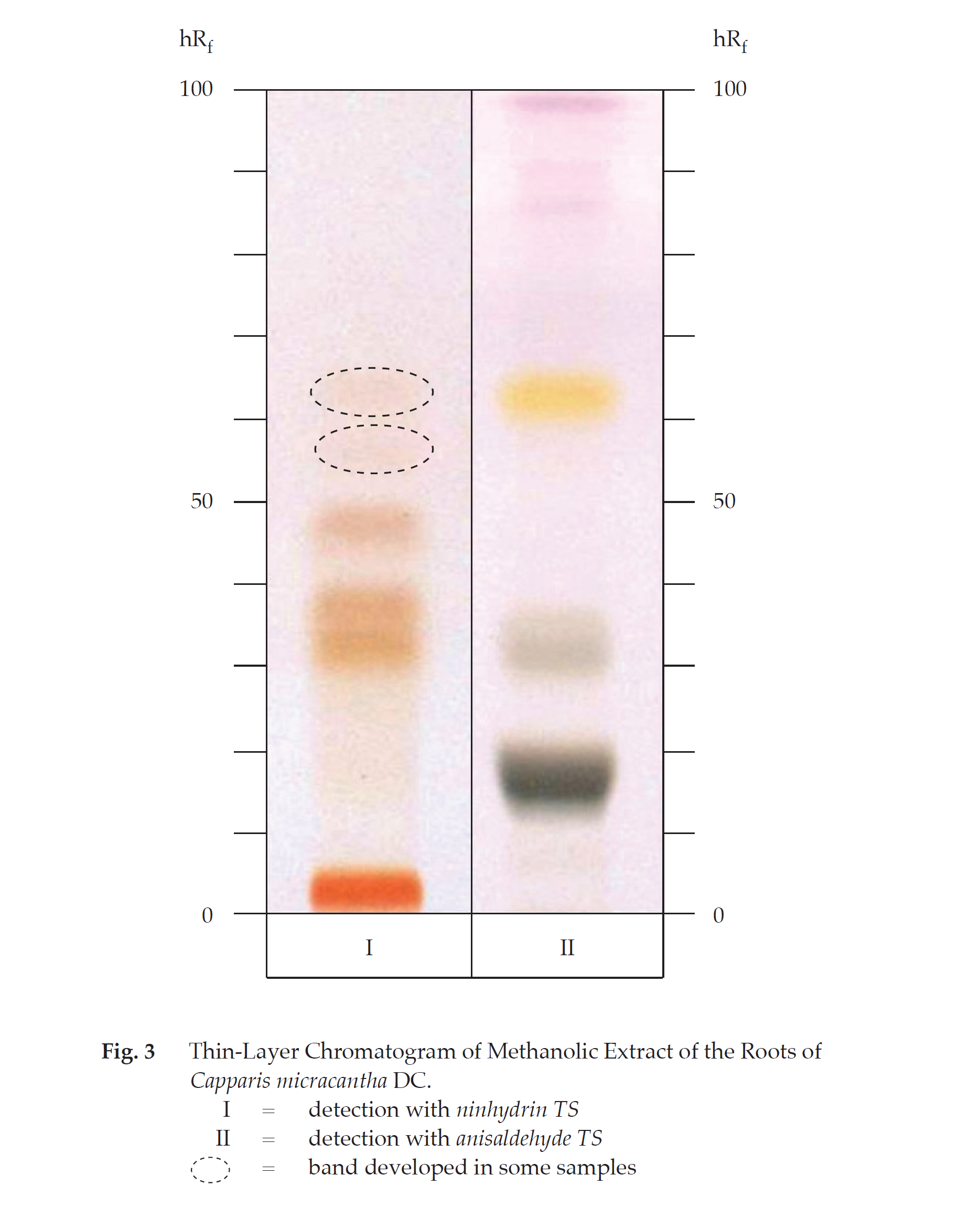ตำรามาตรฐานยาสมุนไพรไทย
Thai Herbal Pharmacopoeia
สำนักยาและวัตถุเสพติด กรมวิทยาศาสตร์การแพทย์ กระทรวงสาธารณสุข
Bureau of Drug and Narcotic, Department of Medical Sciences, Ministry of Public Health(Tinospora crispa (L.) Hook.f. & Thomson)
(Nelumbo nucifera Gaertn.)
(Centella asiatica (L.) Urb.)
(Centella Dry Extract)
(Centella Cream)
(Mesua ferrea L.)
(Piper sarmentosum Roxb.)
(Piper sarmentosum Roxb.)
(Pterocarpus santalinus L. f.)
(Santalum album L.)
(Senna tora (L.) Roxb.)
(Senna alata (L.) Roxb.)
(Senna Alata Tea)
(Piper retrofractum Vahl)
(Myristica fragrans Houtt)
(Andrographis paniculata (Burm. f.) Nees)
(Andrographis Capsules)
(Allium ascalonicum L.)
(Ocimum tenuiflorum L.)
(Curcuma longa L.)
(Turmeric Capsules)
(Turmeric Dry Extract)
(Turmeric Dry Extract Capsules)
(Arcangelisia flava (L.) Merr.)
(Curcuma sp.)
Harrisonia perforata (Blanco) Merr.
(Aristolochia pierrei Lecomte)
(Zingiber officinale Roscoe)
(Ginger Capsules)
(Ginger Tea)
(Cassia fistula L.)
(Nardostachys jatamansi (D. Don) DC.)
(Angelica sinensis (Oliv.) Diels)
Artemisia annua L.
(Ligusticum sinense Oliv. cv. Chuanxiong)
(Neopicrorhiza scrophulariiflora Pennell)
(Atractylodes lancea (Thunb.) DC.)
(Aucklandia lappa Decne)
(Terminalia chebula Retz.)
(Angelica dahurica (Hoffm.) Benth. & Hook. f. ex Franch. & Sav. var. dahurica)
(Kaempferia parviflora Wall. ex Baker)
(Hibiscus sabdariffa L.)
(Roselle Tea)
(Allium sativum L.)
(Zingiber zerumbet (L.) Sm.)
(Wurfbainia testacea (Ridl.) Škorničk.& A. D. Poulsen)
(Cannabis sativa L.)
(Myristica fragrans Houtt)
(Dracaena cochinchinensis (Lour.) S. C. Chen)
(Ficus racemosa L.)
(Hyptis suaveolens (L.) Poit.)
Clerodendrum indicum (L.) Kuntze
(Phyllanthus emblica L.)
(Citrus hystrix DC.)
(Citrus hystrix DC.)
(Areca catechu L.)
(Momordica charantia L.)
Moringa oleifera Lam.
(Aegle marmelos (L.) Corrêa)
(Solanum trilobatum L.)
(Morus alba L.)
Gynostemma pentaphyllum(Thunb.)
Makino
(Clinacanthus nutans (Burm. f.) Lindau)
(Cissus quadrangularis L.)
(Mimusops elengi L.)
(Zingiber montanum (J. König) Link. ex A. Dietr.)
(Piper betle L.)
(Capsicum annuum L.)
(Capsicum Oleoresin)
(Capsicum Gel)
(Piper nigrum L.)
(Piper nigrum L.)
(Eurycoma longifolia Jack)
(Thunbergia laurifolia Lindl.)
(Piper wallichii (Miq.) Hand.-Mazz.)
Senna garrettiana (Craib) H. S. Irwin & Barneby
(Terminalia bellirica (Gaertn.) Roxb.)
(Terminalia chebula Retz.)
(Caesalpinia bonduc (L.) H. Roxb.)
(Tarlmounia elliptica (DC.) H. Rob., S. C. Keeley, Skvaria & R. Chan)
(Hog Creeper Vine Dry Extract Capsiles)
(Hog Creeper Vine Dry Extract)
(Brachypterum scandens (Roxb.) Miq.)
(Lepidium sativum L.)
(Nigella sativa L.)
(Cuminum cyminum L.)
(Foeniculum vulgare Mill.)
(Plantago ovata Forssk.)
(Pimpinella anisum L.)
(Carum carvi L.)
(Anethum graveolens L.)
(Trachyspermum ammi (L.) Sprague)
Albizia procera (Roxb.) Benth.
(Acorus calamus L.)
(Tiliacora triandra (Colebr.) Diels)
Cyanthillium cinereum (L.) H. Rob.
(Orthosiphon aristatus (Blume) Miq.)
Murdannia loriformis (Hassk.) R. S. Rao & Kammathy
(Capparis micracantha DC.)
(Chrysopogon zizanioides (L.) Roberty)
(Cyperus rotundus L.)
(Cannabis sativa L.)
(Syzygium aromaticum (L.) Merr. & L. M. Perry)
(Boesenbergia rotunda (L.) Mansf.)
(Acanthus ebracteatus Vahl)
(Acanthus ilicifolius L.)
(Kaempferia galanga L.)
(Curcuma comosa Roxb.)
Betula alnoides Buch.-Ham. ex D. Don
Cannabis sativa L.
Carthamus tinctorius L
Mitragyna speciosa (Korth.) Havil
Mallotus repandus (Rottler) Müll. Arg
Azadirachta indica A. Juss. var. siamensis Valeton
Azadirachta indica A. Juss. var. siamensis Valeton
Punica granatum L.
Rhinacanthus nasutus (L.) Kurz
Baliospermum solanifolium (Burm.) Suresh
Curcuma aeruginosa Roxb
Boesenbergia kingii Mood & L. M. Prince
Senegalia rugata (Lam.) Britton & Rose
Acacia concinna (Willd.) DC.
Senegalia rugata (Lam.) Britton & Rose
Acacia concinna (Willd.) DC.
Senna alexandriana Mill. var. alexandriana
Cassia acutifolia Delile, Cassia angustifolia Vahl
Butea superba Roxb. ex Willd.
[Plaso superba (Roxb. ex Willd.) Kuntze, Rudolphia superba (Roxb. ex Willd.) Poir.
Pueraria candollei Graham
ex Benth. var. mirifica (Airy Shaw & Suvat.) Niyomdham
Streblus asper Lour.
Suregada multiflora (A. Juss.) Baill. (Gelonium
multiflorum A. Juss.
Capparis Micracantha Root is the dried root of Capparis micracantha DC. (Family Capparaceae), Herbarium Specimen Number: DMSC 5220, Crude Drug Number: DMSc 1089.
Constituents Capparis Micracantha Root contains alkaloids such as capparine B and terpenoids (e.g., capparisditerpenol), etc.
Description of the plant (Figs. 1a, 1b) Shrub or small tree, sometimes scandent; twig nearly terete, base with subulate scales, glabrous or sparsely pubescent when young; thorn directed upwards, 2 to 4 mm long. Leaves simple, alternate, elliptic-oblong, oblong-lanceolate, or ovate-lanceolate, 10 to 30 cm long, 4 to 10 cm wide, apex obtuse, rounded, acute to shortly acuminate, rarely emarginate, base cuneate, rounded, or slightly cordate, membranous when young, coriaceous when mature, glabrous, shiny, often yellowish green when dry, midrib grooved on the upper surface, slightly raised below, secondary veins 5 to 10 on each side of midrib, reticulate veins obvious on both surfaces; petiole 1 to 2.2 cm long. Flowers arranged in supra-axillary rows, up to 7 flowers in each axil; pedicel 0.6 to 2 cm long, pubescent; sepals 4, bi-seriate, outer pairs boat-shaped, inner pairs more or less flattened, ovate to oblong, 0.6 to 1.2 cm long, 3 to 4 mm wide, apex acute to obtuse, pubescent on both surfaces; petals 4, white with yellow base, turning dark red, obovate, 1 to 2 cm long, 3 to 7 mm wide, apex obtuse or rounded, glabrous, distinctly veined; stamens numerous; filament 1.5 to 2.5 cm long; anther 1 to 1.5 mm long; gynophore 2 to 3.5 cm long, glabrous; ovary superior, ovoid to ellipsoid, 2.5 to 3 mm long, 1-loculed, pubescent when young, ovules numerous, stigma sessile, knob-shaped. Fruit subglobose, ovoid to ellipsoid, 1.5 to 7 cm long, 1.5 to 4 cm wide; pericarp woody, orange-red, brown when dry; stipe 3.5 to 4 cm long, 3 to 6 mm thick. Seeds numerous, reniform, about 7 mm long, 5 to 6 mm wide, dark red.
Description Odour, characteristic; taste, slightly bitter.
Macroscopical (Fig. 1a) Obliquely, longitudinally or transversely sliced roots, varied in shape and size; bark 1 to 4 mm thick, light brown to greyish brown, rough; wood pale brown.
Microscopical (Figs. 2a, 2b, 2c, 2d) Transverse section of the root shows periderm, cortex, secondary vascular tissue, and primary vascular tissue. Periderm: lenticels, several layers of rectangular cork cells, cork cambium, and phelloderm. Cortex: polygonal parenchyma (some containing starch grains), groups of sclereids, and fibres. Secondary vascular tissue: secondary phloem, secondary xylem and vascular cambium; secondary phloem, phloem parenchyma (some containing starch grains), phloem fibres and phloem ray; secondary xylem, vessels, axial parenchyma, xylem fibres (some containing obtuse-triangular shaped starch grains), and xylem ray (some containing round shaped starch grains); vascular cambium, several layers of rectangular vascular cambium. Primary vascular tissue: small vessels and small fibres in the centre.
Radial and tangential longitudinal sections of the woody part of the root show secondary vascular tissue; bordered-pitted vessels, axial parenchyma, ray cells, and fibres.
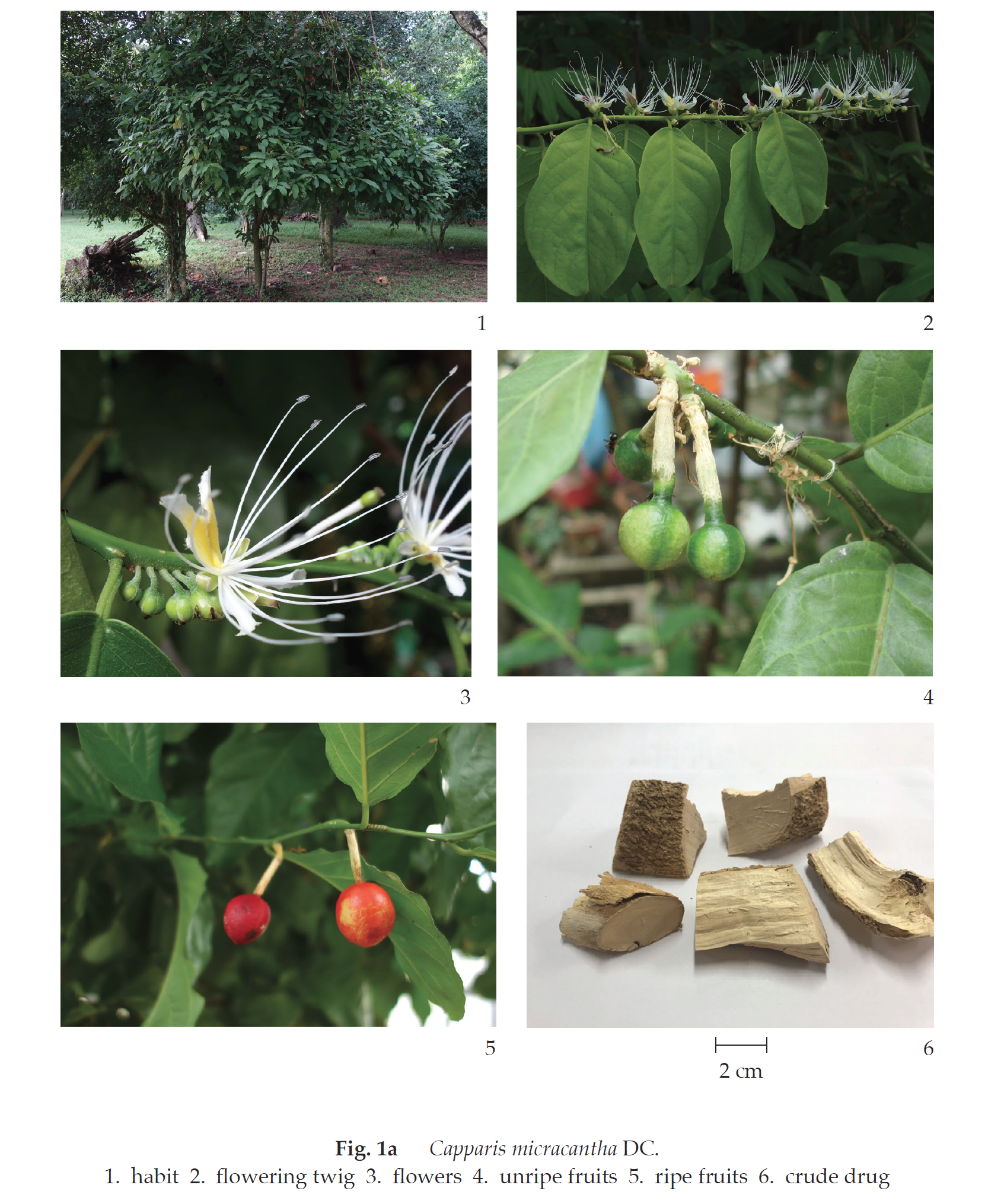
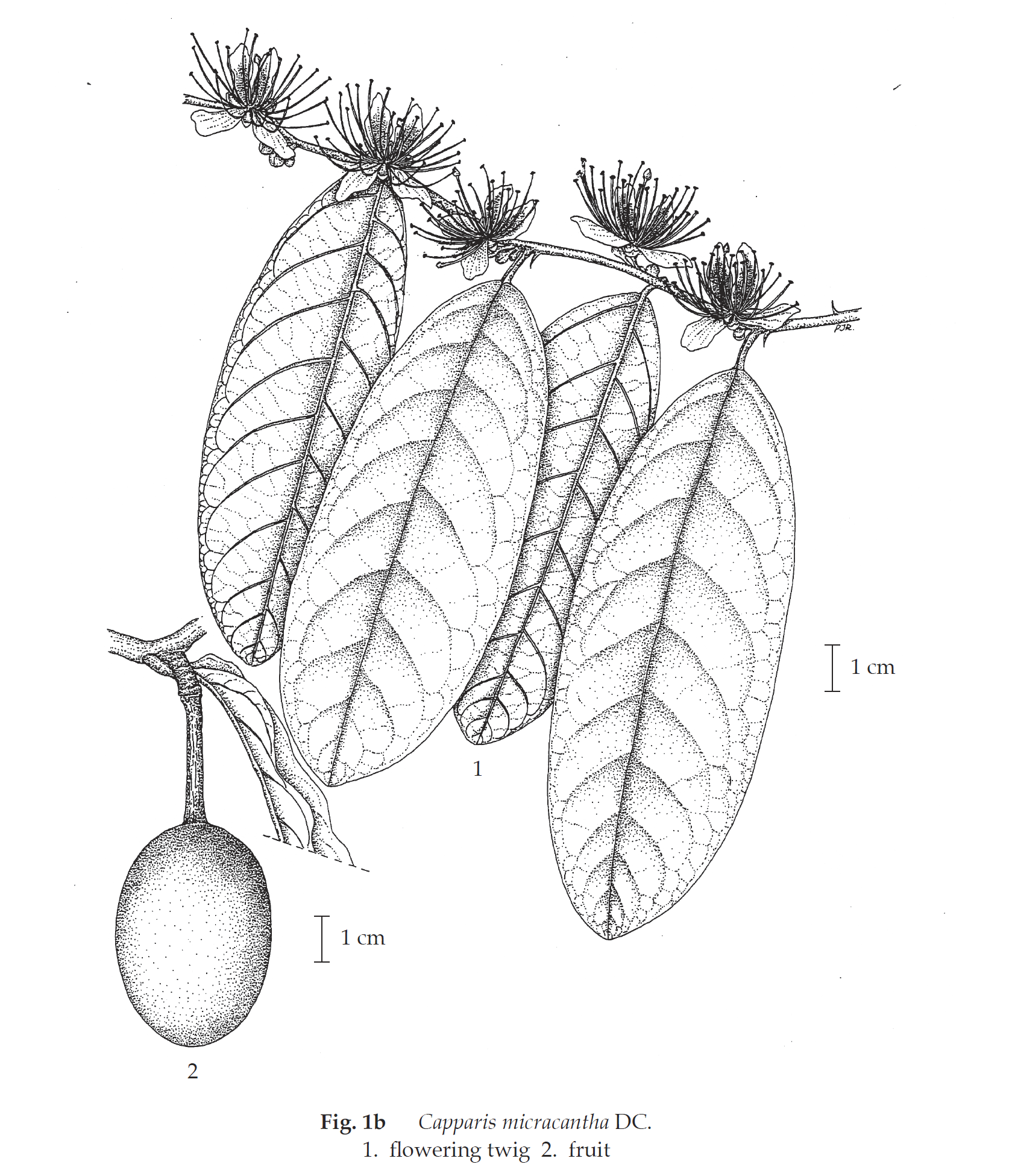
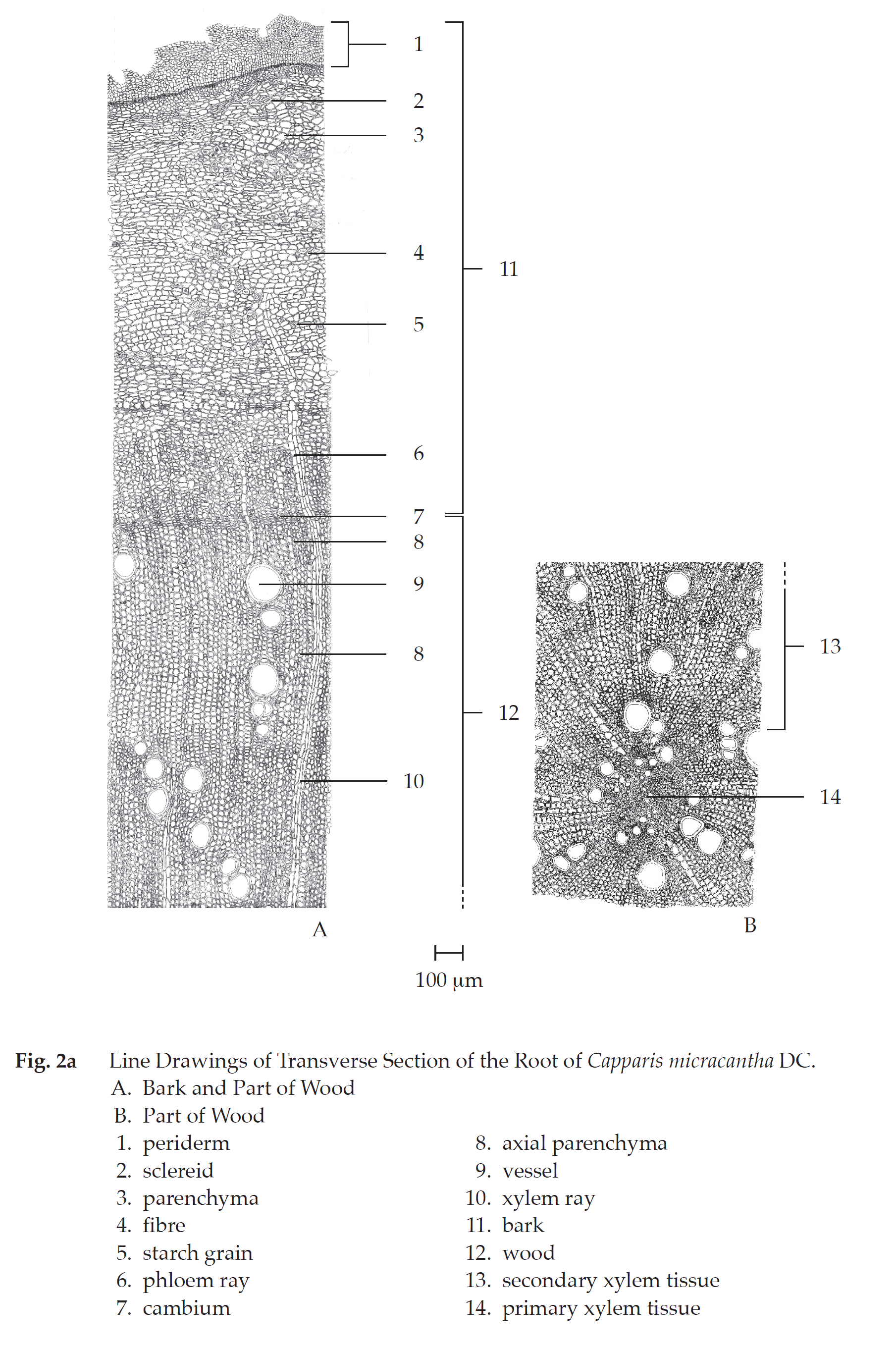
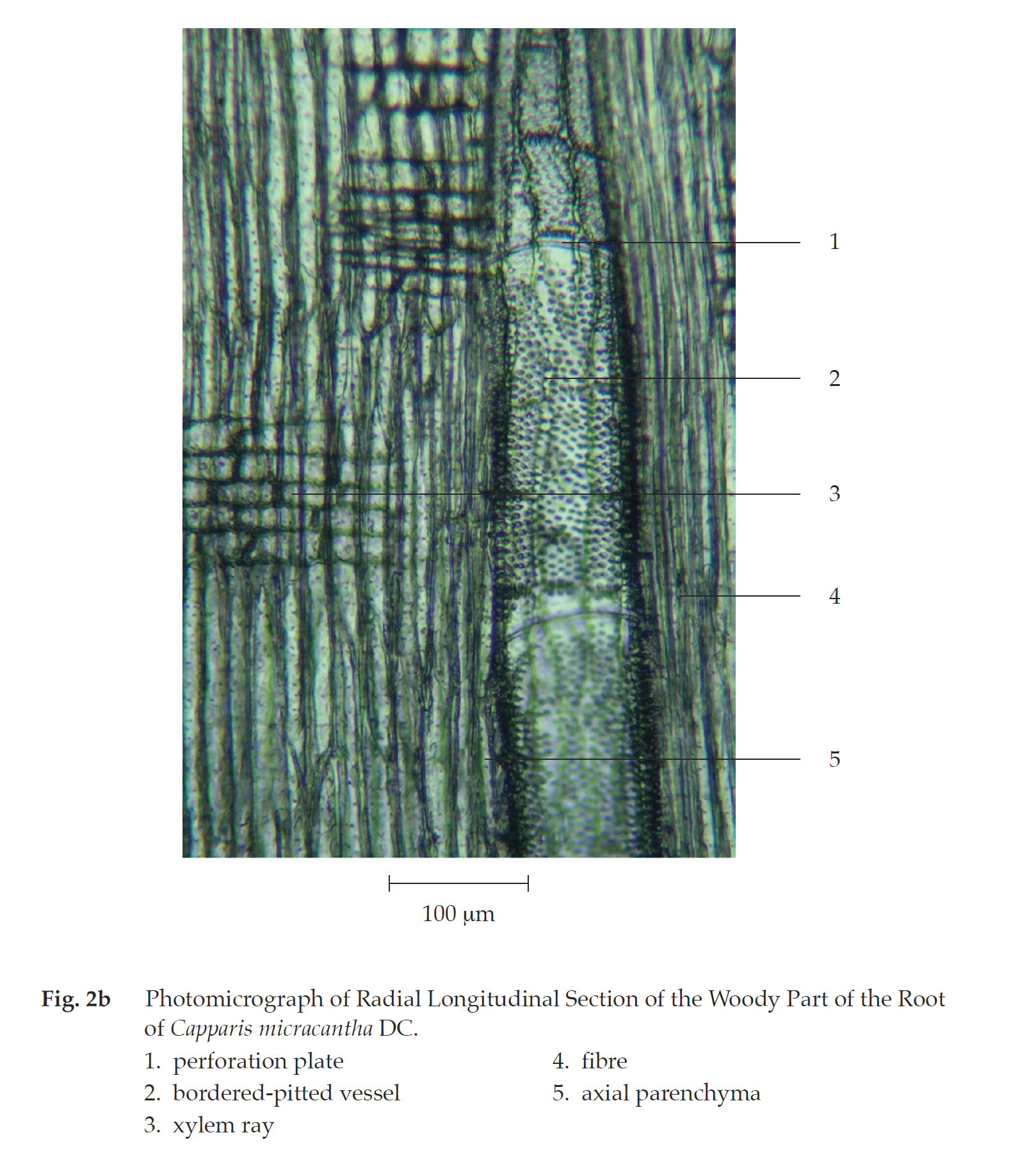


Capparis Micracantha Root in powder possesses the diagnostic microscopical characters of the unground drug. Xylem fibres, with both simple and compound obtuse-triangular shaped starch grains, and xylem ray, with round shaped starch grains, are characteristic features.
Packaging and storage Capparis Micracantha Root shall be kept in well-closed containers, protected from light, and stored in a dry place.
Identification
A. Macerate 1 g of the sample, in powder, with 10 mL of methanol for 30 minutes and filter. To 2 mL of the filtrate, add a few drops of ninhydrin TS, shake well and warm in a water-bath for a while: a purple colour develops.
B. Carry out the test as described in the “Thin-Layer Chromatography” (Appendix 3.1), using a high performance plate with silica gel GF254 as the coating substance and a mixture of 60 volumes of chloroform, 30 volumes of methanol and 10 volumes of formic acid as the mobile phase and allowing the solvent front to ascend 8 cm above the line of application. Apply to the plate as a band of 8 mm, 15 μL of the test solution, prepared by macerating 1 g of the sample, in fine powder, with 10 mL of methanol for 30 minutes and filtering. After removal of the plate, allow it to dry in air. Spray the plate with ninhydrin TS, heat at 105° for 5 minutes and immediately examine the plate. Several purple bands appear (Fig. 3).
Repeat the same procedure on another plate but spray with anisaldehyde TS. One black, one yellowish orange, three violet, and other bands of different colours are observed (Fig. 3).
Loss on drying Not more than 9.0 per cent w/w after drying at 105° to constant weight (Appendix 4.15).
Foreign matter Not more than 2.0 per cent w/w (Appendix 7.2).
Acid-insoluble ash Not more than 2.0 per cent w/w (Appendix 7.6).
Total ash Not more than 5.0 per cent w/w (Appendix 7.7).
Ethanol-soluble extractive Not less than 1.0 per cent w/w (Appendix 7.12).
Water-soluble extractive Not less than 4.0 per cent w/w (Appendix 7.12).
